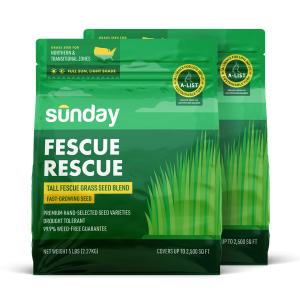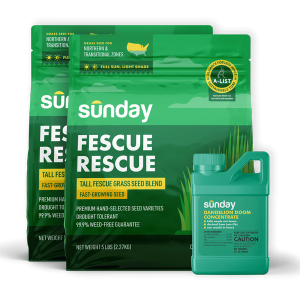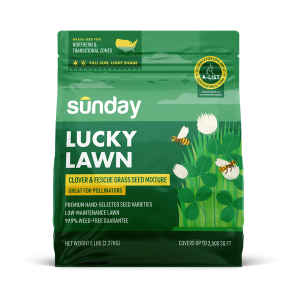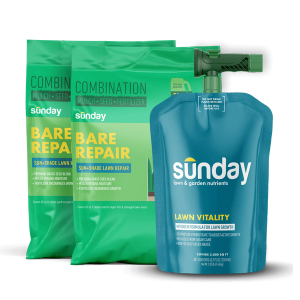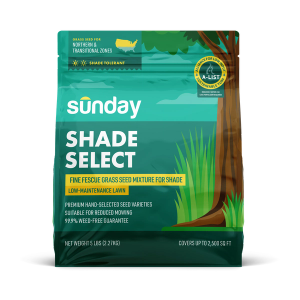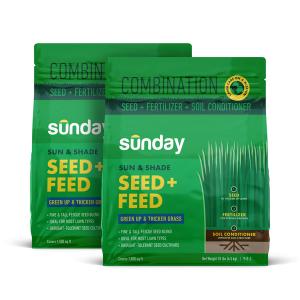What is winter damage?
After its long winter dormancy—enduring brutal temps, chilling winds, and in some cases intense snow—it's likely that your lawn needs some sort of spring damage control.
Winter damage show up as:
- Lawn disease like snow mold
- Grass death aka "winter kill"
- Slow spring greenup due to abnormally cold temperatures or long periods of frost, snow, ice or unexpected winter conditions.
You'll typically identify winter lawn damage in early spring once the snow has melted and your lawn becomes fully visible again.
Sunday Tip:
Not sure if your grass is actually dead, or if it’s just looking dull post-winter? A Bioassay Test can help. To do this, simply cut out a sample of grass (soil and roots and all!), bring it inside in a container, and see if it will grow new shoots and green up. If the grass sample remains brown or golden it’s fairly safe to say it’s dead, and your lawn is in need of help.
Areas in lawns prone to winter damage
Winter damage can intensify in areas of your lawn that are already considered weak. These sections of your grass may be more susceptible to winter damage, including:
- poorly drained soil or low-lying areas where water build-up can hinder growth
- north-facing slopes, where sunshine is not usually able to warm up the soil
- damaged soil structure (like heavy-traffic areas, compaction, or new constructions)
- shady spots that can hinder greenup in spring or hold on to frost longer
- existing bare patches and areas where turf pest damage has occurred
- close proximity to hardscapes where temperature can’t be regulated
- areas with extensive weed issues
How to repair winter damage
Suspect your lawn has endured winter damage? Don’t panic! There are many ways to repair this damage and help your lawn bounce back to its lush, healthy, self. Here are some remedies for winter damage:
- Remove dead or matted patches of grass that are hindering new growth. To do this, use a metal rake and lightly rake the lawn to pull up dead and matted grass, then compost.
- Remove weeds, debris, and other items that are blocking sunlight from reaching the grass. Make sure to treat and control weeds as early as possible in spring to reduce the spread and patch bare spots.
- Fix your soil. To do this, topdress areas where it's hard and compacted, and level your uneven lawn if you notice bumps or unevenness (caused by issues like mole/vole damage, heaving soil, etc.).
- Practice proper watering techniques. Most lawns should receive deep, infrequent watering to help them grow deep roots and produce grass that’s more resilient to changes in extremes.
- Plant better grass and patch bare areas. To do this, lightly rake the soil, then apply seed to the bare, damaged areas. Lastly, cover them with soil amendment and top with water.
Sunday Tip:
Plant cool-season grasses when average daily temperatures are between 40 and 49 degrees Fahrenheit, and warm-season grasses when average daily temps rise to between 60 and 69 degrees Fahrenheit
Common winter damage issues by region
Depending on the location of your lawn—in other words, where you live—you may experience different types of winter damage. Want to level up your lawn repair game? Learn more about your regional climate to help prevent and repair winter damage in a way that's right for your grass.
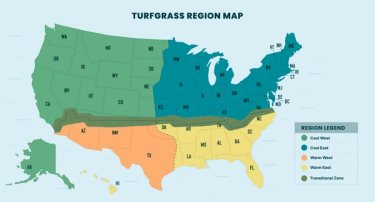
The Warm West
If you live in the Warm West (or the southwest region of the U.S.), winter damage is most commonly the result of improper irrigation, bare spots from previous season drought, or lack of water (for instance, if water restrictions are in place). Springtime conditions can be dry and warm—even in early spring—and are sometimes followed by cold, wet, late springs which impact growth.
Key ways to avoid winter damage in the Warm West
- Water properly through winter into spring. Good watering practices and good drainage can help conserve water and avoid lawn issues.
- Avoid pre-emergence herbicides. You can't apply pre-emergence herbicides and seeds simultaneously, so applying them will delay your grass regrowth.
The Warm East
If you live in the Warm East (or the southeast region of the U.S.), winter damage tends to come from existing patches in warm-season lawns, sitting moisture on lawns, drought stress, uneven watering, or over- and under-fertilizing. Spring conditions here can fluctuate quite a bit due to a range of temperature, precipitation, and light levels. Be mindful of false springs and late frosts to avoid fertilizer applications too early in the season.
Key ways to avoid winter damage in the Warm East
- Repair warm-season lawns as soon as temperatures allow and plant more warm-season grasses in your lawn.
- Fix irrigation and drainage lawn issues by auditing your irrigation and avoiding overwatering.
The Cool West and Cool East
If you live in the Cool West and Cool East (or the northern half of the U.S.), winter damage tends to come from salt damage from proximity to hardscapes, snow damage, snow mold, and poor drainage. Spring conditions can be cold, wet, and coupled with false and/or late springs.
Key ways to avoid winter damage in the Cool East and West
- Manage snow and ice. Distribute snow piles so they melt faster and watch for puddles forming as snow melts. These are likely low areas that may have issues with leveling, compaction, etc.
- Avoid salting your lawn by shoveling properly and applying salt directly to the pavement, not the lawn.
- Practice proper irrigation. Good watering practices and good drainage avoid worsening lawn issues—and also conserve water in the spring.
- Avoid pre-emergence herbicides. You can't apply pre-emergence herbicides and seeds simultaneously, so applying them will delay your grass regrowth.
Get a greener lawn this spring with Sunday
Spring is a great time for more than repairing winter damage! Did you know you can take steps to boost spring greenup? During this post-winter period, you can help by applying fertilizer that contains the right amounts of iron and nitrogen.
- Iron helps to stain grass a deeper green color which actually encourages the soil to warm—and grass to green up more quickly.
- Nitrogen encourages strong, sustained growth for dense turf without harsh chemicals.
OK so...how do you get the right amounts of iron and nitrogen? To repair your winter lawn damage and get the lawn of your dreams this spring, get started with a custom Sunday lawn plan.
Cited sources
Cornell Turfgrass Turf Show Podcast. Cornell Extension.
Frank Fixes Lawns Ep. 1. GetSunday Youtube.







